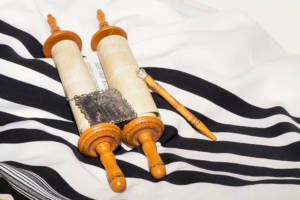Simchat Torah: Scripture as a Living Entity

Every fall, Jewish congregations across the world hold joyful celebrations for one of their religion’s most important books, the Simchat Torah.
Scripture and sacred writings are revered in several religions. Expressions of such reverence can take many forms, including rules on the handling, storage, and reading of sacred texts. Every fall, Jewish congregations across the world hold joyful celebrations for one of their religion’s most important books. Simchat Torah conveys the centrality of the Torah to Jewish culture and faith.
When Is Simchat Torah?
Simchat Torah is a Hebrew phrase that means “rejoicing in Torah,” and it accurately conveys the holiday’s central themes. It’s celebrated on the 22nd or 23rd of Tishrei, the seventh month of the Jewish calendar that usually falls between September and October. This holiday takes place two days after the end of Sukkot, the Feast of Tabernacles that commemorates the ancient Israelites’ wanderings in the Sinai Desert. In Canada, Simchat Torah starts on the evening of October 10 in 2020 and at sunset on September 28 in 2021.
In some parts of the world, Simchat Torah immediately follows another important holiday known as Shemini Atzeret. Translated as “eighth day of assembly,” My Jewish Learning explains that Shemini Atzeret was devoted to the ritual cleansing of the Temple’s altar during the Second Temple Period between 516 B.C.E. and 70 C.E. In Israel and some Jewish communities abroad, Shemini Atzeret and Simchat Torah are combined into one holiday.
Why Is This Holiday Important?
Simchat Torah concludes one annual cycle of Torah readings and signals the start of the next. On this day, the last portion of Deuteronomy and the first passage of Genesis are both read in synagogues. This choice of readings is significant: Deuteronomy’s final passage describes the death of Moses, and the first reading of Genesis contains the creation story. Since both readings take place on the same day, the Torah reading cycle remains unbroken from year to year.
With many Jewish holidays like Hanukkah and Passover, celebrations are centered in the home. Simchat Torah is different because its celebrations primarily take place in synagogues. Chabad describes the hakafot, a procession during which congregants march and dance with the Torah scrolls around the synagogue’s reading table. The hakafot takes place on both the Maariv evening service that starts the holiday and at another service the following day. Many congregations invite all ages and genders to participate, with some carrying their synagogues’ physical Torah scrolls and children carrying flags and smaller Torah scrolls.
The Torah as Teacher and Honored Guest
Rabbi Ronald H. Isaacs of My Jewish Learning mentions that carrying a Torah scroll is considered a great honor. You’re probably not surprised to learn this, but the Torah’s importance goes beyond mere reverence for a holy book. Moment’s Marilyn Cooper mentions that it comes from a verb that means “to shoot,” “to hit a mark,” or “to direct.” Chabad also discusses the concept of The Oral Torah, describing it as insight and wisdom that is essentially “a living, growing organism that cannot be captured by the net of dry ink on a page.”
Not only that, Torah scrolls are treated like royalty. The Sefer Torah are dressed in elaborate cloth mantles or ornate silver cases and adorned with silver crowns. When a Sefer Torah is worn out, it is given a respectful burial.
The Torah Is Alive and Well
The Jerusalem Post’s Stewart Weiss recounts what the rabbi of his congregation once told him about the living Torah. “Our Torah is neither a dead document nor a sterile story,” he said. “The Torah actually has feelings, it has emotions, no less than does a human being…on this one special day, the Torah is boundlessly happy!” Thanks to the minds in which its words have lived, the human hands that have carefully copied every single letter, and the people who listen to its messages today, the Torah does indeed live on.

